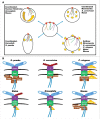Moving and stopping: Regulation of chromosome movement to promote meiotic chromosome pairing and synapsis
- PMID: 28892406
- PMCID: PMC5788555
- DOI: 10.1080/19491034.2017.1358329
Moving and stopping: Regulation of chromosome movement to promote meiotic chromosome pairing and synapsis
Abstract
Meiosis is a specialized cellular division occurring in organisms capable of sexual reproduction that leads to the formation of gametes containing half of the original chromosome number. During the earliest stage of meiosis, prophase I, pairing of homologous chromosomes is achieved in preparation for their proper distribution in the coming divisions. An important question is how do homologous chromosomes find each other and establish pairing interactions. Early studies demonstrated that chromosomes are dynamic in nature and move during this early stage of meiosis. More recently, there have been several studies across different models showing the conserved nature and importance of this chromosome movement, as well as the key components involved in chromosome movement. This review will cover these major findings and also introduce unexamined areas of regulation in meiotic prophase I chromosome movement.
Keywords: LINC; meiosis; recombination; synapsis.
Figures

Similar articles
-
Homologous chromosome pairing: The linchpin of accurate segregation in meiosis.J Cell Physiol. 2024 Jan;239(1):3-19. doi: 10.1002/jcp.31166. Epub 2023 Nov 30. J Cell Physiol. 2024. PMID: 38032002 Review.
-
A bouquet of chromosomes.J Cell Sci. 2004 Aug 15;117(Pt 18):4025-32. doi: 10.1242/jcs.01363. J Cell Sci. 2004. PMID: 15316078 Review.
-
Evidence that masking of synapsis imperfections counterbalances quality control to promote efficient meiosis.PLoS Genet. 2013;9(12):e1003963. doi: 10.1371/journal.pgen.1003963. Epub 2013 Dec 5. PLoS Genet. 2013. PMID: 24339786 Free PMC article.
-
Homologous pairing and the role of pairing centers in meiosis.J Cell Sci. 2011 Jun 15;124(Pt 12):1955-63. doi: 10.1242/jcs.006387. J Cell Sci. 2011. PMID: 21625006 Review.
-
The telomere bouquet is a hub where meiotic double-strand breaks, synapsis, and stable homolog juxtaposition are coordinated in the zebrafish, Danio rerio.PLoS Genet. 2019 Jan 17;15(1):e1007730. doi: 10.1371/journal.pgen.1007730. eCollection 2019 Jan. PLoS Genet. 2019. PMID: 30653507 Free PMC article.
Cited by
-
Visualization and Quantification of Rapid Chromosome Movements at Early Stages of Mouse Meiosis.Methods Mol Biol. 2024;2818:171-177. doi: 10.1007/978-1-0716-3906-1_11. Methods Mol Biol. 2024. PMID: 39126474 Free PMC article.
-
Chromosome separation during Drosophila male meiosis I requires separase-mediated cleavage of the homolog conjunction protein UNO.PLoS Genet. 2020 Oct 1;16(10):e1008928. doi: 10.1371/journal.pgen.1008928. eCollection 2020 Oct. PLoS Genet. 2020. PMID: 33001976 Free PMC article.
-
Does the Pachytene Checkpoint, a Feature of Meiosis, Filter Out Mistakes in Double-Strand DNA Break Repair and as a side-Effect Strongly Promote Adaptive Speciation?Integr Org Biol. 2022 Apr 8;4(1):obac008. doi: 10.1093/iob/obac008. eCollection 2022. Integr Org Biol. 2022. PMID: 36827645 Free PMC article.
-
Diffusion and distal linkages govern interchromosomal dynamics during meiotic prophase.Proc Natl Acad Sci U S A. 2022 Mar 22;119(12):e2115883119. doi: 10.1073/pnas.2115883119. Epub 2022 Mar 18. Proc Natl Acad Sci U S A. 2022. PMID: 35302885 Free PMC article.
-
Out-of-position telomeres in meiotic leptotene appear responsible for chiasmate pairing in an inversion heterozygote in wheat (Triticum aestivum L.).Chromosoma. 2019 Mar;128(1):31-39. doi: 10.1007/s00412-018-0686-5. Epub 2018 Nov 27. Chromosoma. 2019. PMID: 30483879
References
Publication types
MeSH terms
LinkOut - more resources
Full Text Sources
Other Literature Sources
